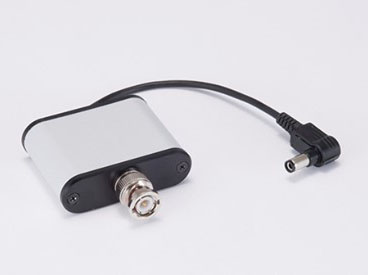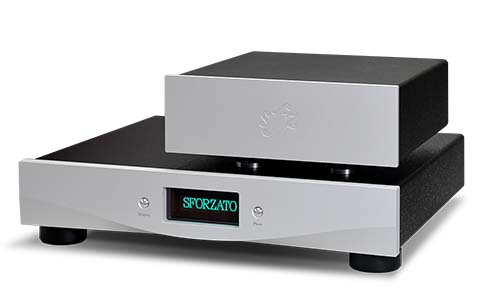Sforzato DSC−030EX DAC with ZERO LINK input
Specifications
Power Supply: 234 (W) x 236 (D) x 92 (H) mm
Power Supply: 3.9 kg
Supported Formats
AIFF, WAV, FLAC, ALAC
Equipped with the latest ZERO LINK digital interface
This is an innovative synchronizing interface that uses the clock from the DAC and sends synchronized to that clock data from NAS to the DAC. This completely frees the DAC from asynchronous work that breaks the rhythm of the digital‐to‐analog conversion and allows you to work without fluctuating workloads.
The potential of ZERO LINK can only be realized when the transport will be connected to Sforzato DSC series via DVI cable. This interface can transmit high‐speed digital signals and has a reliable connection.

D/A Converter
The latest ES9038Pro is used for the D/A converter in monaural, one for each channel. The ESS DAC no longer relies on internal jitter removal, running in perfect sync with signal input. To fully demonstrate the performance of the 9038Pro, which has about four times the current output of the 9018S, a large‐scale I‐V conversion circuit reproduces a vast sound field and a precise and delicate sound image.
External Clock
It does not have a clock oscillator inside the housing, and a dedicated external clock is attached. A high‐performance TCXO (temperature‐compensated crystal oscillator) with ultra‐low near‐phase noise of −120 dBc / Hz @ 10 Hz with the clock architecture deploying a specialized IC that achieves jitter below 100 fs (1 femtosecond = 1/1000 of a picosecond).
Power for the external clock is supplied from the rear panel of the main unit. Of course, you can enjoy higher quality sound by using a higher PMC clock.

Thorough elimination of jitter
All digital audio, including network players, operate relative to the master clock when converting digital data to analog, so the quality of the clock is directly linked to sound quality. In particular, noise near the transmission frequency of the clock cannot be removed by the PLL or other circuits in the subsequent stage, so the performance of the transmitter directly affects the sound quality. The ultra‐low near‐phase noise clock creates a master clock (the heartbeat of digital audio) together with the ultra‐low jitter PLL.
Furthermore, a special dedicated IC with a jitter of 100 fs (1 femtosecond = 1/1000 of picosecond) or less is used for clock division and distribution. In addition, the master clock of the D/A converter is transmitted as a differential signal.
Power supply with a margin
The power supply is a separate housing. The noise from the transformer is completely blocked. A large and generous power supply using a large‐capacity toroidal transformer with separate digital and analog stages and an ultra‐high‐speed, ultra‐low‐noise SiC Schottky diode contributes to powerful and soulful music playback.
Inside the main unit, a high‐performance low‐noise LDO LT1763 is used for the digital part, and POL (Point of Load) that regulates in the immediate vicinity of the required part is thoroughly implemented. In addition, the 3.3V power supply for the analog part of the D/A converter has a feedback type discrete power supply that uses an ultra‐high‐speed, high‐precision error amplifier arranged independently on the left and right. Non‐feedback type discrete power supplies are arranged independently for the positive and negative power supplies for analog output. The optimum power supply for each function is deployed in the optimum position.
Discerning internal wiring and output terminals
With the cooperation of Sekiguchi Machinery Sales Co., Ltd. (Acoustic Revive), the internal wiring uses an elliptical single‐wire PC‐triple C wire. The purity of the power supply and signal is ensured by using a laborious wiring method that does not use a connector as much as possible. Two output systems, balanced XLR and unbalanced RCA, are available. Both use Hi‐End terminals.
Careful topology and thorough noise countermeasures
The board is a double‐sided 8‐layer board. The top and bottom surfaces are widely ground planes, and most of the digital signals are wired to the inner layer. Noise is suppressed to the utmost by the strong shielding effect. In addition, electromagnetic noise removal sheets and Finemet beads are installed in place to remove high‐frequency interference.
Software updates
By inserting the USB memory into the USB‐A terminal provided on the rear panel and performing the update operation, you can easily update the software by yourself. It will continue to evolve even after you purchase the device.




